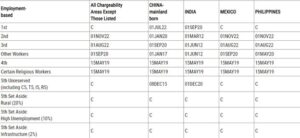
Green Light for Your Green Card: EB-5 Visa Availability Creates Unique Filing Window
The EB-5 Reform and Integrity Act of 2022 (RIA) made significant changes to the EB-5 program. The EB-5 visa program, which grants US green cards to foreign nationals who invest in US businesses and create jobs, is an important program for those that have a direct financial impact on the US economy and job market. The recent passage of the EB-5 Reform and Integrity Act of 2022 was a major overhaul of the EB-5 program and included major reforms aimed at increasing oversight, transparency and targeting of investment to needier areas. For those that are seeking an EB-5 visa, one of the most important creations of the EB-5 “set asides” that are design to reserve a portion of the total available EB-5 visas for rural areas, areas of high unemployment, and investments that focus on infrastructure. Not only do these set asides allow for a lower investment amount, they also, as of this article, are all current on the visa bulletin.
Changes in how EB-5 Appears on the Visa Bulletin
More details about the EB-5 set asides will be discussed below, but it is important to understand how to read the EB-5 portion of the visa bulletin now. Prior to the passage of the RIA, the EB-5 program consisted of two different lines on the visa bulletin. There was a line for the non-regional center investments and a line for the regional center investments. However, on June 30, 2021, the EB-5 regional center program sunset and needed to be reauthorized by congress. Enter, the RIA which was enacted on March 15, 2022. With the implementation of the RIA, the visa bulletin now looks like this:

The EB-5 unreserved is for those investments that were made prior to the RIA or any post-RIA investments that do not qualify for the set aside visas. Conversely, the set asides are listed in three different rows along with the percentage of the EB-5 visas that are set aside for each category. When considering an EB-5 investment, it is important to look at the visa bulletin. Recent changes in USCIS policy allow for the concurrent filing of the I-526 (or I-526E) and the I-485 to adjust status in the United States when dates are current.
What are the EB-5 Set Asides?
The 2022 RIA introduced three main set asides for EB-5 visas. These set asides account for 32% of the overall EB-5 preference category for a given fiscal year, leaving 68% for unreserved. The three set aside categories are:
- Rural Targeted Employment Area (TEA) – 20% of EB-5 visas are now reserved for investments in rural areas. This is defined as areas in which there is a population of less than 20,000 people or a low population density of less than 50 people per square mile.
- High Unemployment TEA – 10% of EB-5 visas are now reserved for investments in areas with high unemployment. USCIS requires a description of the census tract(s) and unemployment statistics that allow USCIS to make a case specific designation as an area of unemployment. There should be at least 150% of the national average unemployment rate in the area to qualify.
- Public Infrastructure Projects – 2% of EB-5 visas are now set aside for public infrastructure projects that focus on constructing, renovating, or expanding public infrastructures like roads, bridges, airports, water treatment facilities or similar endeavors. USCIS’ policy manual defines these are projects that are administered by a government entity (federal, state, or local), where the governmental entity, which serves as the job-creating entity, contracts with a regional center or a new commercial enterprise to receive capital, and the project involves financing for maintaining, improving, or constructing a public works project.
Notably for petitions filed on or after March 15, 2022, USCIS designations of TEAs are valid for 2 years from the date of investment for standalone investors or 2 years from the date a regional center files a Form I-956F and may be renewed for one or more 2-year periods.
EB-5 Investment Amounts
Not only did the RIA create the set aside allocations, it also changed the investment amounts. For Non-Set Aside investments, one must invest at least $1,050,000 into the project to qualify for an EB-5, along with other factors that must be shown. For set aside investments, the amount is $800,000. Please note, these are subject to change, and the RIA provides that adjustments should occur every five years based on inflation and tied to the CPI. The next investment change should occur in 2027.
Benefits of an EB-5 Set Aside
As shown above, right now the set-aside visas are current for all nationalities. This is in stark contrast to EB-1 through EB-3 especially for China and India. Given the USCIS policy of now allowing the concurrent filing of the I-485, there are tremendous benefits in filing for a current EB-5 visa category.
- Establishing your EB-5 Priority date – Your EB-1, EB-2, or EB-3 priority dates are not portable to EB-5. So filing for your EB-5 I-526 will establish that priority date. Being able to file concurrently with the I-485 will allow you to take advantage of the benefits of having a pending I-485 that are discussed below.
- Freezes your children’s ages to prevent aging out – given recent changes in USCIS Child States Protection Act (CSPA) guidance, the filing of the I-485 should lock in your child’s age and prevent them from aging out. This is, at present, only possible for EB-5 set aside for those from China or India.
- Applying for travel authorization – Advance Parole (Form I-131) can be filed concurrently with an I-485. This will allow you to leave the US with the pending I-485, not abandon it, and re-enter without having to go through visa stamping for your nonimmigrant visa.
- Applying for work authorization – the C9 EAD available for those with a pending I-485 will allow an unrestricted right to work. This is especially important for those that are about to max out on L time or want to engage in additional work other than their main employer.
Conclusion
The EB-5 Reform and Integrity Act of 2022 brought major changes to the EB-5 investor visa program. Most notably for immigrants, it has created set asides for rural, high unemployment, and infrastructure projects. These set asides offer lower investment thresholds of $800,000 and currently have visa availability, allowing concurrent I-526 and I-485 filings. For foreign investors seeking permanent US residency, the EB-5 program offers a unique green card path in today’s backlogged system. The set asides incentivize investments that have positive economic impacts on underserved communities. With dedicated EB-5 legal counsel, investors can properly structure qualifying projects, document source of funds, and meet all program requirements.
The recently introduced EB-5 set asides present unique benefits for immigrant investors and American communities. With current visa bulletin priority dates, obtaining US green cards is more achievable, especially for Chinese and Indian nationals facing long EB-2 and EB-3 backlogs. But the time to act is now. Consulting with an experienced EB-5 attorney provides the best chance at successfully navigating this complex but rewarding program.
Reddy Neumann Brown PC, located in Houston, Texas, has been serving the business community for over 25 years and is Houston’s largest immigration law firm focused solely on U.S. Employment-based immigration. We work with employers, employees and investors helping them navigate the immigration process quickly and cost-effectively.
By: Steven Brown
Steven Brown is a Partner at Reddy Neumann Brown PC where he works in the Non-immigrant visa department and leads the Litigation Team. His practice covers all phases of the non-immigration visa process including filing H-1B, L-1, E-3, H-4, and H-4 EAD petitions. In the last two years, Steven has successfully handled over 1,000 non-immigrant visa petitions including filing petitions, responding to any necessary Requests for Evidence, and drafting motions and appeals. He has also become a key resource for F-1 students that seek guidance on properly complying with the F-1 visa regulations and any OPT or CPT issues they may have. Additionally, Steven holds a weekly conference call for companies that are part of one of the largest organizations for IT Services companies in America.

